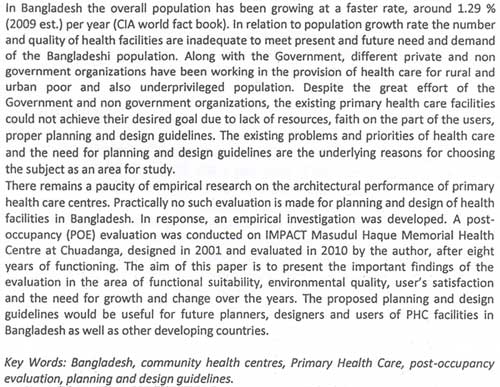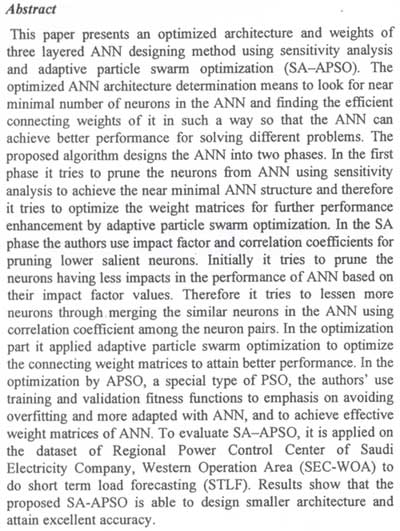|
|
|
|
|
|
| |
|
|
| |
Magazine Papers |
|
| |
|
|
| |
|
Magazine
Paper |
Date |
|
"Post-occupancy evaluation of a designed community health centre in
Bangladesh- Lessons to be learnt for future planning and design” 30th
International Seminar for Public Health Group (PHG) of the Union of
International Architects (UIA) at Kualalampur Convention Centre 29th
November 2010-1st December 2010 |
November 2010 |
|
|
| |
|
|
| |
Post-occupancy evaluation of a designed community health centre in
Bangladesh- Lessons to be learnt for future planning and design |
|
| |
*Jasmin Ara Begum, Prof. Dr. |
|
| |
|
|
| |
Abstract |
|
| |
 |
|
| |
|
|
| |
* Professor, Department of Architecture |
|
| |
Ahsanullah University of Science and Technology, Dhaka. |
|
| |
|
|
| |
|
|
| |
|
|
| |
|
|
| |
|
Magazine
Paper |
Date |
|
“Architecture and Weight
optimization of ANN Using Sensitive Analysis and Adaptive Particle
Swarm Optimization” IJCSNS International Journal of Computer Science
and Network Security, VOL.10 No. 8, August 2010. |
August 2010 |
|
|
| |
|
|
| |
Architecture and Weight optimization of ANN Using Sensitive Analysis and Adaptive Particle Swarm Optimization |
|
| |
Muhammad
Shah Faisal*,
Khairul Hasan Md.; Moinul Haque Mohammad; and Ahmed Sumon |
|
| |
|
|
| |
 |
|
| |
|
|
| |
* Lecturer, Department of CSE |
|
| |
Ahsanullah University of Science and Technology, Dhaka. |
|
| |
|
|
| |
|
|
| |
|
|
| |
|
Magazine
Paper |
Date |
|
"Treatment of Textile Wastewater in Bangladesh" published in the magazine "Bangladesh
Cotton, April 2008". |
April 2008 |
|
|
| |
|
|
| |
Treatment of Textile Wastewater in Bangladesh |
|
| |
Prof. Dr. Md.
Mahbubul Haque* |
|
| |
|
|
| |
Abstract |
|
| |
Bangladesh is heavily involved with textile production and export.
Over the years a lot of textile mills were established in the country
mostly in and around Dhaka city. Large number of these textile mills
generates and discharge waste waters. In this article the present
scenario of textile wastewater treatment i<<Selection in Document>>n Bangladesh is discussed.
The main effluent generating industries are (i) Knit dyeing units,
(ii) woven dyeing units, (iii) Denim plants, (iv) Printing units, and
(v) Garments washing units. Different dyes and chemicals are required
to treat different fibres. While different stage of operation
generates different types of effluents. Different dye generates
different level of toxicity. Basically two types of treatment
philosophies are adopted and the corresponding plants are designated
as (i) Physico-Chemical Plants where effluent is treated by physico
chemical process followed by biological treatment, and (ii) 100%
Biological plants, where the effluent is treated by only biological
process. Other forms of pollution like air pollution and noise
pollution is also discussed. |
|
| |
|
|
| |
* Professor, Department of Technology Technology |
|
| |
Ahsanullah University of Science and Technology, Dhaka. |
|
| |
|
|
| |
|
|
| |
|
|
| |
|
Magazine
Paper |
Date |
|
"Study on the preparation
of Epoxy Polymeric Composites" published in the magazine "Textile Today, January 2008". |
January 2008 |
|
|
| |
|
|
| |
Study on the
preparation of Epoxy Polymeric Composites |
|
| |
Mohammad Rafiqur
Rashid1 and B K Kandola2 |
|
| |
|
|
| |
Abstract |
|
| |
A
composite material is a combination of two or more chemically
different materials with a distinct interface between them. The main
components of composite materials are fibres and matrix. In this study
a series of epoxy composite laminates reinforced with glass, carbon,
aramid and hybrid (glass/carbon, glass/aramid) fabrics with different
weave structures and area densities are prepared. This thesis is to
study the curing cycle of epoxy resin by Differential Scanning
Calorimetry (DSC) and influence of resin uptake percentage on
variation of reinforcing fibre type and geometry. For determination of
curing cycle of the epoxy resin, several experiments have been carried
out using DSC. The analysis of the physical properties of the
composites laminates indicates that resin uptake percentage
depends on the area density of the fabric. Lower area density fabric
has higher resin uptake than higher density fabric. |
|
| |
|
|
| |
1. Asst. Prof. Department of Textile Technology, |
|
| |
Ahsanullah University of Science and Technology, Dhaka. |
|
| |
2. Professor, Department of Textile Technology, University of Bolton,
UK. |
|
| |
|
|
| |
|
|
| |
|
|
| |
|
Magazine
Paper |
Date |
|
"Search for an
affordable shelter for urban poor" published in proceedings of
the International Seminar on "Architecture for the Economically
Disadvantaged" at Bangladesh University of Engineering & Technology (BUET),
March 2007 |
March 2007 |
|
|
| |
|
|
| |
Search for an affordable shelter for urban poor |
|
| |
Md. Afzal Hossain1 & Prof. Khairul Enam2 |
|
| |
|
|
| |
Abstract |
|
| |
The paper
aims to search for an affordable housing for the urban poor in
Bangladesh, where the basic human needs are greatly fulfilled with
improved living conditions. Worldwide low cost housing is a subsidized
sector to some extent but the total achievement is found to be very
little compared with the enormity of the problem. The low cost housing
issues are addressed all over the developing countries according to
their respective socio-cultural and economic aspects which again have
a wide variation in strategies and goals. It is a general
conscientious that there is a need for reforms in policy planning
level for equitable distribution of resources to all sections of the
population. |
|
| |
|
|
| |
The
Government of Bangladesh built some low cost houses at Tongi, Demra,
Mirpur and Bhasentec to meet the need of homeless people. These
developments could not offer much to the targeted shelter-less
families as a whole. The housing situation of Dhaka city is
characterized by very high land price with ever increasing price of
building materials and labour. |
|
| |
|
|
| |
The paper
attempts to find out guidelines for a sustainable low cost housing for
the urban poor particularly for Dhaka city. This is understood that to
realize the above objective there will be a series of reforms and
changes required in housing finance, amortization, land distribution
and infrastructure layout that needs to be accommodated under the
existing situation of management and administration. It also includes
the study of different cost effective building materials, structural
systems, durability, building size and form, social acceptance and
land required according to BNBC. |
|
| |
|
|
| |
1. Lecturer, Department of Architecture |
|
| |
Ahsanullah University of Science and Technology, Dhaka. |
|
| |
2. Professor, BUET. |
|
| |
|
|
| |
|
|
| |
|
|
| |
|
Magazine
Paper |
Date |
|
"Avenue - The Beauty
of City" published in the daily newspaper "Daily Amar Desh,
January 20, 2007" |
January 2007 |
|
|
| |
|
|
| |
Avenue
- The Beauty of City |
|
| |
Architect Ayasha Siddiqua* |
|
| |
|
|
| |
Abstract |
|
| |
Avenue,
the window of city, space for breathing, the beauty of city. It
enhances the prettiness, good looks of any city. Though our lots of
emerging urban issues we have few avenues which are one of main
attractive places for urban life. Besides its own purpose these
avenues can be used for recreational and breathing space for cit
dwellers, lots for holiday market, shelter space for emergency-some
natural disaster (earth quake), above all its beautification can
contribute to the overall beauty of city. |
|
| |
|
|
| |
* Lecturer, Department of Architecture |
|
| |
Ahsanullah University of Science and Technology, Dhaka. |
|
| |
|
|
| |
|
|
| |
|
|
| |
|
|

